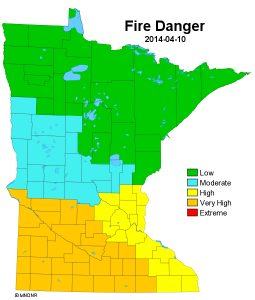While the quick snow melt has meant good things for most of us, including athletes and farmers who are both waiting to get into their fields, it’s bad news for firefighters around Minnesota.
The snow cover limits the danger of wildfires. And while there was plenty of moisture this winter in comparison to, say, the 2011-2012 season, the rapid melt has sent it into rivers and streams instead of into the ground.
 That’s put southwestern and south central Minnesota at a high risk, according to the Minnesota Department of Natural Resources.
That’s put southwestern and south central Minnesota at a high risk, according to the Minnesota Department of Natural Resources.
The DNR announced Thursday, April 10 that burning restrictions are in place nearly statewide, through some municipalities can issue variances for specific burns.
According to the DNR: A “High” index means fires start easily and spread at a fast rate. All fine dead fuels ignite readily and fires start easily from most causes. Unattended campfires are likely to escape. Fires spread rapidly and short-distance spotting is common. High-intensity burning may develop on slopes, or in concentrations of fine fuel. Fires may become serious and difficult to control unless they are hit hard and fast while small.
In the Iron Range and Minnesota’s so-called “Arrowhead” area, restrictions are not in place due to heavier moisture content and a slower melt.
“Warm temperatures will continue to erode the snowpack in the next few weeks,” said Larry Himanga, DNR fire prevention coordinator. “This will expose last year’s leaves and other yard waste. The safest way to dispose of this vegetation is to recycle or compost it.”
Spring fire restrictions will severely limit open burning until summer green up occurs. Traditionally, most wildfires occur in April and May. More than 95 percent of these fires are caused by human error. Due to the high fire incidence during this period, the DNR initiates burning restrictions to coincide with this annual “fire season.”
The restrictions are weather dependent, but normally last from four to six weeks until there is sufficient green vegetative growth. Historically, spring fire restrictions dramatically decrease the number and size of accidental fires, the state said.
If the DNR or a fire department has to respond to an escaped fire, the homeowner is responsible for the cost.